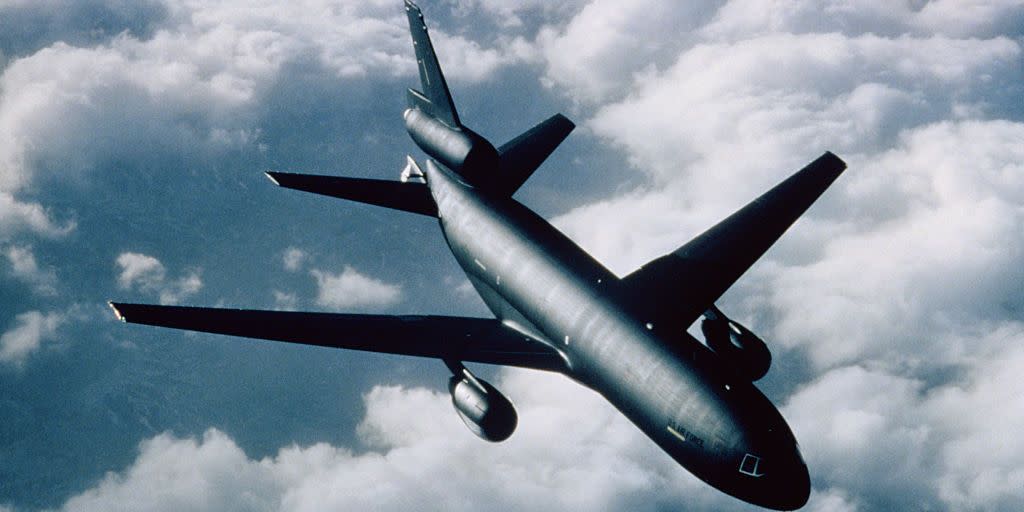The Air Force Is Dumping a Plane So Hot, It's Called 'Big Sexy'

For 40 years, the KC-10—a.k.a. “Big Sexy”—has provided unparalleled refueling and cargo capability for the U.S. Air Force.
With the arrival of the KC-46 Pegasus, refueling squadrons are phasing out the KC-10 to make room for the new tanker.
Travis Air Force Base, one of two AFBs that operate the plane, will fly its last KC-10 in September 2024.
While next-gen fighter jets and bombers like the F-35 and B-21 get lots of love, the U.S. Air Force would grind to a halt without its refueling tankers. Airplanes like the venerable KC-135 and the KC-10 top off these badass warplanes with fuel, all while supplying some impressive cargo-carrying abilities. But with the arrival of the U.S. military’s newest tanker, the KC-46 Pegasus, three is officially a crowd—and so the KC-10, nicknamed “Big Sexy” for its alluring sleek wing design, is now beginning its slow send off into retirement.
“She’s a good plane,” Scott E. Speck, a flight engineer with the 70th Air Refueling Squadron (ARS) at Travis Air Force Base in California, said in a press release. “She is temperamental at times, but always in good ways. And she takes care of you.”
The KC-10 (technically the KC-10A Extender) may seem like an odd choice for retirement— after all, it’s nearly 30 years younger than the KC-135 and it can haul nearly twice as much fuel. However, there are many more KC-135s in service. Right now, the Air Force fields 59 KC-10s, while 359 KC-135s fly the skies. With the costs associated with keeping an entirely unique airframe up and running, the Air Force can save much-needed money (for those fancy fighter jet programs, for example) by whittling its refueling needs down to two planes.
With the Air Force receiving its first KC-46 Pegasus (after a litany of delays and headaches) in 2019, the plan is to eventually have a 479-plane refueling fleet filled with 300 KC-135s and 179 KC-46s. While the Pegasus will be the most advanced refueling plane ever built, the stratotanker will remain the refueling backbone of the U.S. Air Force.
The KC-10, based on the McDonnell Douglas DC-10, beat out the competition in the Advanced Tanker Cargo Aircraft Program, mainly for its ability to operate on short runways, and came into service in 1982, serving in several conflicts including the Gulf War and the wars in Afghanistan and Iraq. The 70th ARS at Travis AFB is one of two Air Force bases that operate the Extender (the other being Joint Base McGuire-Dix-Lakehurst in New Jersey) and received its first KC-10A Extenders on September 1, 1994. Thirty years later, Travis AFB will officially fly its last KC-10 in September 2024.
Earlier this month, Joint Base McGuire-Dix-Lakehurst announced that it’d begun the KC-46 transition and had conducted the first sortie with the Pegasus on January 4, 2023. But for the crew of the 32nd ARS stationed there, the moment was a bittersweet one.
“They’ve seen, firsthand, the incredible capability the KC-10 brought to the fight, and they are extremely proud of being a part of that legacy,” 32nd ARS commander Tyler Smith said in the press release. “At the same time our aircrew are very excited about the KC-46 [and] the advanced warfighting capabilities it now brings to the fight.”
Although with a smaller cargo capacity, the KC-46 will deliver increased flexibility, survivability, and battlefield data via the Advanced Battle Management System. However, it’s unlikely the crews that flew the KC-10 Extender will forget “Big Sexy” anytime soon.
“A more capable aircraft may never be built compared to the KC-10A Extender,” says 70th ARS chief boom operator Donald Davis. “The range, fuel delivery and cargo capability are second to none.”
You Might Also Like


